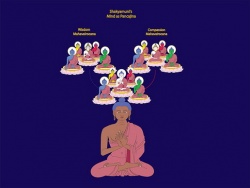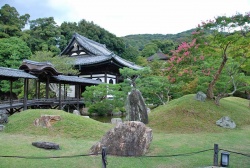Difference between revisions of "Commentary on the Meditation Sutra"
| (4 intermediate revisions by 2 users not shown) | |||
| Line 1: | Line 1: | ||
[[File:010.jpg|thumb|250px|]] | [[File:010.jpg|thumb|250px|]] | ||
| − | (Ch. Kuan wu-liang-shou ching shu) | + | (Ch. [[Kuan wu-liang-shou ching shu]]) |
| − | (Jp. Kammuryoju-kyo sho) | + | (Jp. [[Kammuryoju-kyo sho]]) |
| − | The Kuan wu-liang-shou ching shu, known by its abbreviated title the Kuan-ching shu (Kangyo-sho), is the great | + | The [[Kuan wu-liang-shou ching shu]], known by its abbreviated title the [[Kuan-ching shu]] ([[Kangyo-sho]]), is the great {{Wiki|Chinese}} [[Pure Land]] [[master]] [[Shan-tao's]] most important work. In this work, he made a number of radical advances in [[Pure Land]] [[thought]] which laid the foundations for the subsequent [[development]] of [[Pure Land Buddhism]] in [[China]] and [[Japan]]. [[Shan-tao]] became [[Honen's]] greatest [[influence]] for having developed the [[nembutsu]] as the reciting of [[Amida"s]] [[name]] rather than the [[visualization]] of him in his [[Pure Land]]. |
| − | The main [[thought]] of the [[Meditation | + | The main [[thought]] of the [[Meditation Sutra]], as suggested by its title, is to encourage [[visualized]] [[meditation]] on [[Amida Buddha]] and his [[Pure Land]]. However, [[Shan-tao's]] commentary presents a radical reinterpretation. He states as follows: |
| − | It is true that the benefits of the two gateways known as the contemplative and non-contemplative practices are expounded in a previous section of the [[sutra]]. Nevertheless, when seen in terms of the [[meaning]] of Amida's original [[vow]], [[Shakyamuni's]] intent in preaching the [[sutra]] was actually to have [[sentient beings]] wholeheartedly and single-mindedly utter the [[name]] of Amida.(T. 1753. 37: 278a) | + | It is true that the benefits of the two gateways known as the {{Wiki|contemplative}} and non-contemplative practices are expounded in a previous section of the [[sutra]]. Nevertheless, when seen in terms of the [[meaning]] of [[Amida's]] original [[vow]], [[Shakyamuni's]] intent in preaching the [[sutra]] was actually to have [[sentient beings]] wholeheartedly and [[single-mindedly]] utter the [[name]] of [[Amida]].(T. 1753. 37: 278a) |
| − | As is shown in the above passage, [[Shan-tao]] interpreted the main purport of the [[sutra]] in [[light]] of the [[discussion]] of Amida's original [[vow]] set forth in the [[Sutra of Immeasurable Life]], and, as a result, the [[sutra]] came to be understood more in terms of recitation than visualization. | + | As is shown in the above passage, [[Shan-tao]] interpreted the main purport of the [[sutra]] in [[light]] of the [[discussion]] of [[Amida's]] original [[vow]] set forth in the [[Sutra of Immeasurable Life]], and, as a result, the [[sutra]] came to be understood more in terms of {{Wiki|recitation}} than [[visualization]]. |
| − | Chinese [[Pure Land]] thinkers of every period have regarded the [[Sutra of Immeasurable Life]] and the [[Meditation]] [[Sutra]] as inseparable and sought to reconcile the [[idea]] of [[Buddha's]] [[universal]] [[compassion]] in the [[Sutra of Immeasurable Life]] with the emphasis on [[visualization]] practice in the [[Meditation]] [[Sutra]]. It was Shan-tao's commentary, however, which became the normative mode of establishing accord between the two [[sutras]]. [[Honen]] also followed [[Shan-tao]] in this regard. | + | {{Wiki|Chinese}} [[Pure Land]] thinkers of every period have regarded the [[Sutra of Immeasurable Life]] and the [[Meditation]] [[Sutra]] as [[inseparable]] and sought to reconcile the [[idea]] of [[Buddha's]] [[universal]] [[compassion]] in the [[Sutra of Immeasurable Life]] with the {{Wiki|emphasis}} on [[visualization]] practice in the [[Meditation]] [[Sutra]]. It was [[Shan-tao's]] commentary, however, which became the normative mode of establishing accord between the two [[sutras]]. [[Honen]] also followed [[Shan-tao]] in this regard. |
| − | Before and during Honen's [[time]] on Mt. Hiei, a commentary on the Kuan wu-liang-shou ching attributed to the [[ | + | Before and during [[Honen's]] [[time]] on {{Wiki|Mt. Hiei}}, a commentary on the [[Kuan wu-liang-shou ching]] attributed to the {{Wiki|Chinese}} [[T'ien-T'ai]] [[master]] [[Chih-i]] was held as the {{Wiki|orthodox}} interpretation of this important [[sutra]]. [[Honen]], however, was [[not satisfied]] with this commentary and came to use [[Shan-tao's]] which was viewed as unorthodox at the [[time]]. |
| − | In 1021, the | + | In 1021, the [[Fourteenth Patriarch]] of the {{Wiki|Chinese}} [[T'ien-T'ai]] school, [[Chi-rei]] (960-1028), wrote his [[Kuan-chin-shou Miao-tsun-shou]] which was a commentary on [[Chih-i's]] Commentary on the [[Meditation Sutra]]. Since that [[time]], it became customary to read [[Chih-i's]] commentary in [[light]] of [[Chi-rei's]] commentary. This {{Wiki|custom}} became {{Wiki|orthodoxy}} on {{Wiki|Mt. Hiei}}. |
[[File:Kaisan-do kangets.jpg|thumb|250px|]] | [[File:Kaisan-do kangets.jpg|thumb|250px|]] | ||
| − | If we compare Chih-i's commentary (from the Chi-rei [[view]]) and Shan-tao's commentary, three basic differences emerge. The first concerns [[human beings]]. T'ien-T'ai's [[view]] is that the nature of all [[sentient beings]] and [[buddhas]] is the same, while Shan-tao's [[view]] is {{Wiki|opposite}}. [[Shan-tao]] felt [[human nature]] was always in opposition to the nature of [[buddhas]]. The second [[difference]] concerns the role of the [[nembutsu]]. T'ien-T'ai insists on the contemplative aspect of the [[nembutsu]] through simply [[holding]] it in one's [[mind]], while [[Shan-tao]] stressed the practical use of the [[nembutsu]] through frequent recitation. The third [[difference]] concerns the [[buddha]] [[body]] and [[buddha lands]]. T'ien-T'ai speaks of [[Amida Buddha]] and the [[Pure Land]] as [[elements]] of one's [[consciousness]] to be [[realized]] in the [[mind]]. [[Shan-tao]], on the other hand, spoke of the substantial [[existence]] of both [[Amida Buddha]] and the [[Pure Land]]. In the end, as [[Honen]] became aware of the differences, he abandoned the T'ien-T'ai [[view]] and appropriated Shan-tao's which had been rejected by the community on Mt. Hiei. | + | If we compare [[Chih-i's]] commentary (from the [[Chi-rei]] [[view]]) and [[Shan-tao's]] commentary, three basic differences emerge. The first concerns [[human beings]]. [[T'ien-T'ai's]] [[view]] is that the [[nature]] of all [[sentient beings]] and [[buddhas]] is the same, while [[Shan-tao's]] [[view]] is {{Wiki|opposite}}. [[Shan-tao]] felt [[human nature]] was always in [[opposition]] to the [[nature]] of [[buddhas]]. The second [[difference]] concerns the role of the [[nembutsu]]. [[T'ien-T'ai]] insists on the {{Wiki|contemplative}} aspect of the [[nembutsu]] through simply [[holding]] it in one's [[mind]], while [[Shan-tao]] stressed the {{Wiki|practical}} use of the [[nembutsu]] through frequent {{Wiki|recitation}}. The third [[difference]] concerns the [[buddha]] [[body]] and [[buddha lands]]. [[T'ien-T'ai]] speaks of [[Amida Buddha]] and the [[Pure Land]] as [[elements]] of one's [[consciousness]] to be [[realized]] in the [[mind]]. [[Shan-tao]], on the other hand, spoke of the substantial [[existence]] of both [[Amida Buddha]] and the [[Pure Land]]. In the end, as [[Honen]] became {{Wiki|aware}} of the differences, he abandoned the [[T'ien-T'ai]] [[view]] and appropriated [[Shan-tao's]] which had been rejected by the {{Wiki|community}} on {{Wiki|Mt. Hiei}}. |
{{R}} | {{R}} | ||
[http://jsri.jp/English/Pureland/SUTRAS/kammuryoju-kyo/zendocom.html jsri.jp] | [http://jsri.jp/English/Pureland/SUTRAS/kammuryoju-kyo/zendocom.html jsri.jp] | ||
Latest revision as of 18:45, 22 February 2015
(Ch. Kuan wu-liang-shou ching shu)
(Jp. Kammuryoju-kyo sho)
The Kuan wu-liang-shou ching shu, known by its abbreviated title the Kuan-ching shu (Kangyo-sho), is the great Chinese Pure Land master Shan-tao's most important work. In this work, he made a number of radical advances in Pure Land thought which laid the foundations for the subsequent development of Pure Land Buddhism in China and Japan. Shan-tao became Honen's greatest influence for having developed the nembutsu as the reciting of Amida"s name rather than the visualization of him in his Pure Land.
The main thought of the Meditation Sutra, as suggested by its title, is to encourage visualized meditation on Amida Buddha and his Pure Land. However, Shan-tao's commentary presents a radical reinterpretation. He states as follows:
It is true that the benefits of the two gateways known as the contemplative and non-contemplative practices are expounded in a previous section of the sutra. Nevertheless, when seen in terms of the meaning of Amida's original vow, Shakyamuni's intent in preaching the sutra was actually to have sentient beings wholeheartedly and single-mindedly utter the name of Amida.(T. 1753. 37: 278a)
As is shown in the above passage, Shan-tao interpreted the main purport of the sutra in light of the discussion of Amida's original vow set forth in the Sutra of Immeasurable Life, and, as a result, the sutra came to be understood more in terms of recitation than visualization.
Chinese Pure Land thinkers of every period have regarded the Sutra of Immeasurable Life and the Meditation Sutra as inseparable and sought to reconcile the idea of Buddha's universal compassion in the Sutra of Immeasurable Life with the emphasis on visualization practice in the Meditation Sutra. It was Shan-tao's commentary, however, which became the normative mode of establishing accord between the two sutras. Honen also followed Shan-tao in this regard.
Before and during Honen's time on Mt. Hiei, a commentary on the Kuan wu-liang-shou ching attributed to the Chinese T'ien-T'ai master Chih-i was held as the orthodox interpretation of this important sutra. Honen, however, was not satisfied with this commentary and came to use Shan-tao's which was viewed as unorthodox at the time.
In 1021, the Fourteenth Patriarch of the Chinese T'ien-T'ai school, Chi-rei (960-1028), wrote his Kuan-chin-shou Miao-tsun-shou which was a commentary on Chih-i's Commentary on the Meditation Sutra. Since that time, it became customary to read Chih-i's commentary in light of Chi-rei's commentary. This custom became orthodoxy on Mt. Hiei.
If we compare Chih-i's commentary (from the Chi-rei view) and Shan-tao's commentary, three basic differences emerge. The first concerns human beings. T'ien-T'ai's view is that the nature of all sentient beings and buddhas is the same, while Shan-tao's view is opposite. Shan-tao felt human nature was always in opposition to the nature of buddhas. The second difference concerns the role of the nembutsu. T'ien-T'ai insists on the contemplative aspect of the nembutsu through simply holding it in one's mind, while Shan-tao stressed the practical use of the nembutsu through frequent recitation. The third difference concerns the buddha body and buddha lands. T'ien-T'ai speaks of Amida Buddha and the Pure Land as elements of one's consciousness to be realized in the mind. Shan-tao, on the other hand, spoke of the substantial existence of both Amida Buddha and the Pure Land. In the end, as Honen became aware of the differences, he abandoned the T'ien-T'ai view and appropriated Shan-tao's which had been rejected by the community on Mt. Hiei.

